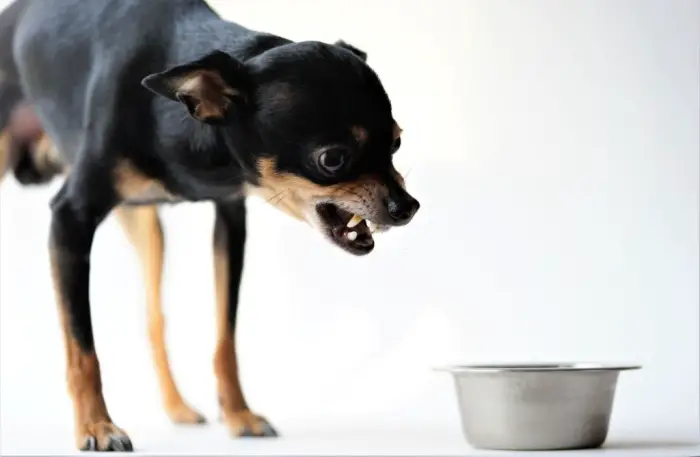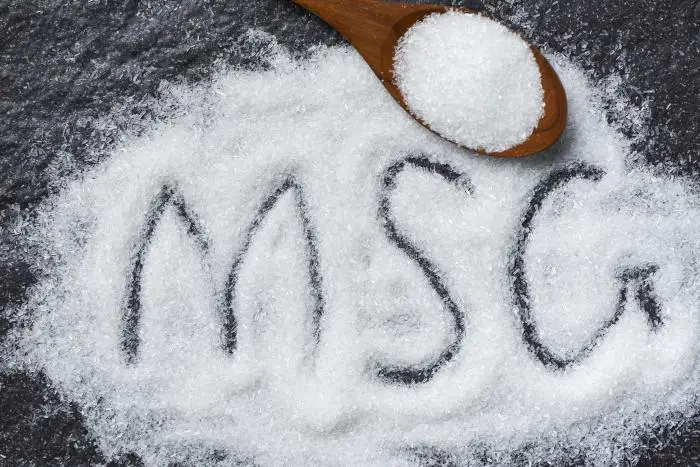In terms of choosing the best food for your dogs, you have to be aware of the harmful dog food ingredients as they can harm your dog’s overall health.
Such dog food ingredients provide no nutritional value, cause digestive problems, and so on. This is the reason why you must be careful when choosing dog food. If possible, look for expert advice to choose the right dog food to keep your pet healthy and happy.
If you’re shopping around for dog food, make sure to avoid these ingredients on the label:
1. Monosodium Glutamate (MSG)
Typically used as a flavor enhancer for both dog and human food to make up for the flavor that low-quality ingredients lack, MSG can cause health problems. It doesn’t provide real benefits for your dog and may even cause allergies.
By law, most companies that produce dog food don’t list MSG and often list protein isolate, calcium caseinate, guanylate, autolyzed yeast, natural flavors, yeast extracts, and more.
2. Sodium Nitrite
Nitrates and nitrites, typically found in most processed meats, such as deli meats, hotdogs, ham, bacon, and sausages, are preservatives used to extend a meat product’s shelf life. Processed meats are high-salt and high-fat items that can be occasional treats for your pets, but they’re the foods that your dogs shouldn’t eat.
Approved as a preservative in dog food and other pet food products, sodium can be toxic in high doses, which can cause methemoglobin, a blood disorder.
3. Corn Syrup
It’s a food syrup that’s made from corn’s starch. It contains sugar, such as dextrins, maltose, and dextrose, as well as oligosaccharides, which make up about 50% of corn syrup. Too much corn syrup may cause diabetes and obesity in dogs. Although it’s a sweetener, your dog doesn’t require corn syrup or some sugars in their food to ensure nutritional balance.
4. Propylene Glycol
It isn’t only in several dog food products, but also in some savory products. However, it’s also an FDA-approved ingredient used for human food. like salad dressings.
While it’s okay for humans to consume foods with propylene glycol, it isn’t clear that the same is true for dogs. Since it’s known as toxic for cats, it’s best to avoid dog food with this ingredient.
5. Animal Byproducts
Never be confused with the ingredient label ‘meat’ as actual meat. Real meat offers your pet protein and some beneficial components. However, meat meals or animal byproducts don’t come from quality meat sources. Such types of meat sources are seen as harmful ingredients because of their manufacturing process.
Usually, manufacturers include harmful parts of meats collected from different places. Such parts include expired meats from the grocery store stocks. Animal byproducts or compacted meat go through a process that removes pathogens. But, the problem is that this kind of process doesn’t guarantee to work. So, make sure to purchase dog food with clear meat descriptions and never settle for the ones that are generally labeled.
6. Gluten
While some people avoid gluten to lose weight and improve their digestion, the reasons why you should avoid this ingredient in dog foods are compelling. Since gluten is found in grains, it isn’t a natural food for cats or dogs to consume.
When it comes to dog food, gluten may be found in gluten-containing grains, like barley or wheat. Also, wheat gluten may be found as an ingredient used as binders to form the kibble texture and shape.
Dogs are more receptive to a gluten-containing grain than cats, but there are still many that develop allergies or experience digestive distress because of the high quantity of grains in the traditionally processed kibble diet. Chronic ear infections and stinky ears, hot spots, and itching are the common signs of gluten allergy or sensitivity in your pet.
7. Artificial Coloring And Food Dyes
A food dye isn’t a necessary dog food ingredient. However, it’s found in a huge number of brands that are sold in stores these days. The artificial coloring doesn’t add nutritional value to what your dogs are eating. It’s there to catch your pet’s attention.
If possible, skip the bright colors and give your pet a chance to enjoy a healthy diet. Avoid labels that contain yellow, red, blue, and caramel coloring. If you prefer your dog’s food to look great, just look for products with natural colors.
8. Melamine
This kind of plastic contains nitrogen, which is added to some dog food products to make them look like they contain more protein. Once ingested, melamine can be toxic and may cause kidney failure, depending on the dose and size of the dog. It may also cause death when your dog ingested too much of it.
9. Ethoxyquin
It’s a synthetic additive that’s used as fat preservatives in most dog food products. Although ethoxyquin is non-toxic in a small trace amount, it can have a negative effect on your pet’s health, depending on the dosage. For instance, it may affect your dog’s liver, as well as their liver enzymes in the blood.
Unlike other dog food ingredients, ethoxyquin isn’t always added to food and doesn’t appear on the label. This ingredient may sneak into the dog food and can result in health problems after continuous consumption. Thus, your best bet is to look for reliable dog food brands that use natural preservatives only in their formulation to help you achieve your dog’s optimum health.
10. Rendered Fat
Like meat meals, another dog food ingredient you should avoid at all costs is rendered fat. It isn’t a quality source of macro-nutrient. Typically, the fat found in dog food is from a combination of low-grade sources, which can have negative effects on the overall health condition of your pet. Manufacturers often include fat from dangerous sources, like roadkill.
Wrapping Up
Choosing the best dog food plays an important role in your pet’s health condition. So, make sure to avoid the above harmful dog food ingredients and opt for products formulated with the healthiest and natural ingredients.
If possible, look for dog food with natural preservatives, real meat protein, and whole foods ingredients. Such foods don’t only have better nutritional value for dogs, but they won’t also put your dog’s health at risk.
Related Post:



